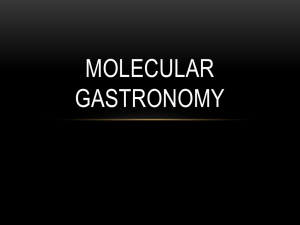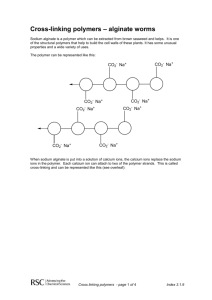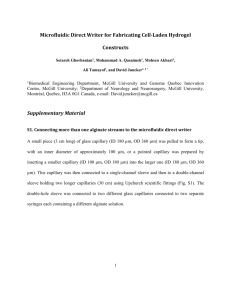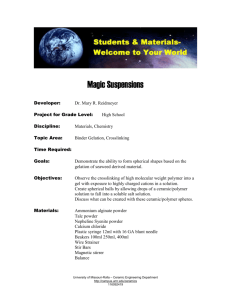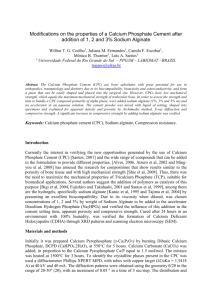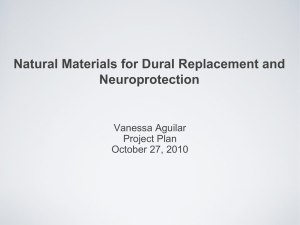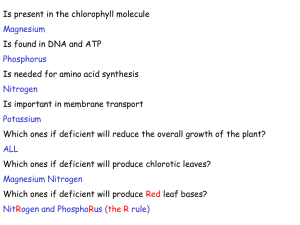UD Programs Concept 3: Provide physical and
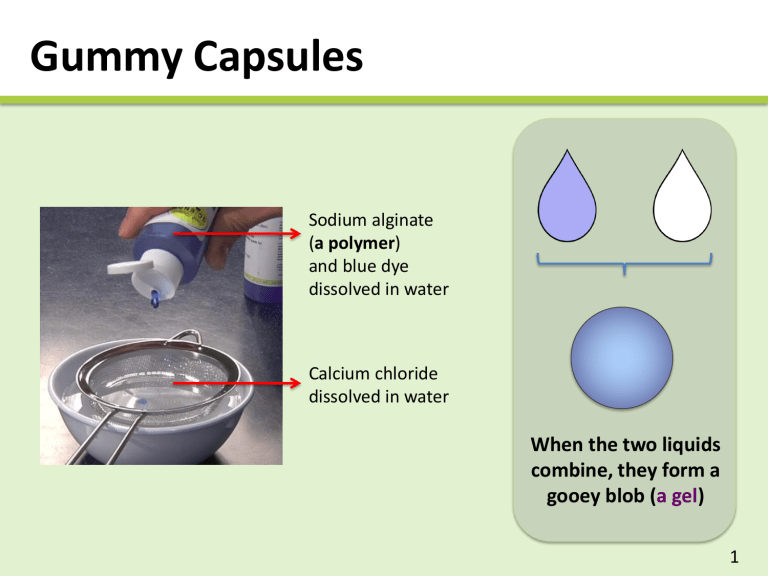
Gummy Capsules
Sodium alginate
(a polymer) and blue dye dissolved in water
Calcium chloride dissolved in water
When the two liquids combine, they form a gooey blob ( a gel )
1
What’s a Polymer?
Polymers are made up of many, many molecules all strung together to form really long chains.
Polymer chains often get tangled up, like a mound of spaghetti.
http://pslc.ws/macrog/kidsmac/index.htm
http://chemwiki.ucdavis.edu/Wikitexts/Simon_Fraser_Chem1%3A_Lower/States_of_Matter/Polymers_and_Plastics
2
What are Hydrogels?
polymer
• Hydrogels are 3-dimensional polymer networks that are filled with water
• Contain so much (>90%) water that they’re kind of like “solid” water
• Have properties between those of solids and liquids water
Schematic of a polymer gel
3
How do Gummy Capsules Form?
Gels form when the polymer networks are crosslinked
Crosslinks are bonds between different polymer chains http://www.intechopen.com/source/html/37702/media/image2_w.jpg
Add calcium ions
When you drop sodium alginate into the calcium solution:
• Calcium replaces sodium
• Calcium forms crosslinks
• Why does this change matter? Unlike
Na + ions, Ca 2+ ions can form two bonds
4
Spherification vs. Reverse Spherification
Sodium alginate
Calcium chloride
Spherification
Drop alginate into calcium chloride
Why does order matter?
Calcium ions are much smaller than strands of sodium alginate, so they can move (diffuse) much faster
Sodium alginate
Calcium lactate
Reverse Spherification
Drop calcium lactate into alginate
Sodium alginate
Calcium chloride
5
Spherification vs. Reverse Spherification
Sodium alginate
Calcium chloride
• Calcium moves into the drop, so gelation occurs inside the sodium alginate drop
• After rinsing, calcium keeps moving toward the center
• Gummies become more solid over time
Calcium lactate
Sodium alginate
• Calcium moves into the alginate bath, so gelation occurs on the outside of the drop
• After rinsing, the reaction stops, since rinsing removes the un-reacted alginate
• Gummies are stable
6
Factors that Affect the Gummies
• Amount of calcium in the alginate solution
• If the sodium alginate solution contains any calcium, gelation (crosslinking) can happen before you drop it into the calcium chloride
• Preventing/fixing this problem: o If you’re dissolving the sodium alginate in a liquid other than water, make sure it doesn’t contain calcium ( e.g.
, milk)
• pH of the alginate solution
• If the pH of the sodium alginate solution is too low, the hydrogen concentration will be too high and alginate won’t react with the calcium
• Preventing/fixing this problem: o Measure the pH of your sodium alginate solution (shouldn’t be an issue if you’re just dissolving the sodium alginate in water) o If the pH is too low, add some sodium citrate
7
Another Tasty Hydrogel: Jello!
Candy connection: Jello!
http://www.intechopen.com/source/html/17237/media/image13.png
Cool
[Hot] [Cold]
Jello/gelatin
• Dissolve gelatin in hot water; let it cool
• As the gelatin solution cools, the structure changes and crosslinks form
8
Capillary Action and Chromatography
Capillary action is the ability of a liquid to flow in narrow spaces— even against gravity.
Chromatography is a method for separating a mixture into different parts.
Some types of chromatography, like paper
chromatography, rely on capillary action.
9
Capillary Action in Nature
10
Capillary Action
Liquid wets walls of tube, increasing surface area.
Surface tension acts to decrease surface area, pulling liquid up.
Wetting continues from a higher level, causing liquid to continue rising.
Eventually the liquid reaches a height at which its weight is balanced by surface tension. After this, the height stays constant.
For a more thorough discussion of Capillary Action, you can watch a recording of our brown-bag from March 17, 2014.
http://www.nisenet.org/search/product_category/online-workshops-31 http://chemwiki.ucdavis.edu/Under_Construction/chem1/States_of_Matter/Liquids_and_their_Interfaces
11
Paper Chromatography Activity
(1) Draw on paper
(2) Squirt a drop of water onto the paper
(3) Hold the paper vertically
Water and ink move up the paper, against gravity
12
Paper Chromatography
• Water-soluble parts of the ink dissolve into the water
• Dye moves with the water up the paper, due to capillary action
• Different dyes travel different amounts
• The distance each dye travels depends on how the dye dissolves in the water and how the dye interacts with the paper
Water and ink move up the paper, against gravity
13
Candy Chromatography
• Dampen candy slightly, then rub candy onto the filter paper
OR
• Dissolve candy in water, then use a pipette or popsicle stick to transfer a small drop onto the filter paper
• Let paper dry
Activity write-ups:
• http://howtosmile.org/record/9665
• http://www.scientificamerican.com/article/bringscience-home-candy-chromatography/
• http://www.sciencebuddies.org/science-fairprojects/project_ideas/FoodSci_p006.shtml
• Then suspend filter paper in a container of water
• Many people think a 0.1% NaCl solution works better than pure water
14
Will the Colors Separate?
• Most of our foods can only use 7 synthetic colorants
• Brown M&Ms worked the best for me (most separation)
• I didn’t see color separation for orange Skittles or M&Ms; maybe the dye is just Yellow #6, instead of a combination of red and yellow dyes
Orange M&M
Name
Blue #1
Blue #2
Color
Dark turquoise blue
Dark navy blue
Blue
Red #3 Red
Red #40 Dark red
Yellow
#5 Yellow
Yellow
#6 Dark orange Brown M&M
Green #3 Dark blue-green http://www.fda.gov/forindustry/coloradditives/coloradditiveinventories/ucm115641.htm
Green(?)
Yellow
Red
Green M&M
15
Why do the Colors Separate?
Why do some colors move further than others?
Like dissolves like
• Water is polar (charges aren’t distributed evenly)
Red = more negative Blue = more positive
• The most polar dyes dissolve in water the best, and move the farthest
So if we change the solvent, colors dissolve differently and move different amounts
From left: blue, green, red, yellow
To get more info on this experiment: http://www.rfwp.com/samples/dr-daves-chemistry.pdf#page=4
16
Other Chromatography Methods
• Universal goal : for the different parts of a material to move at different speeds, so they can be separated and/or analyzed
• One example : HPLC, where a pressurized liquid moves through a column filled with silica beads
• Materials can be separated into parts based on different properties, such as
• Charge, polarity
• Hydrophobicity
• Affinity
• Size, shape http://www.saylor.org/site/wp-content/uploads/2012/07/Chapter121.pdf
Liquid chromatography system from Agilent
More Resources
•
Descriptions of different spherification ingredients http://www.molecularrecipes.com/spherification/started-spherification/
•
Good description of science behind spherification http://itschemicallydelicious.wordpress.com/2013/02/07/the-science-behind-spherification/
• “What is Jello-O?” (
Scientific American ) http://www.scientificamerican.com/article/what-is-jell-o-how-does-i/
• “What’s that Stuff: Jell-O” ( Chemical and Eng.
News ) http://pubs.acs.org/cen/whatstuff/stuff/8120jello.html
• Good discussions of paper chromatography with food dyes (discusses the changes you get when you dip the paper into water versus other liquids) http://micro.sci-toys.com/node/45
• Paper chromatography with markers, using water and alcohol http://www.kyantec.com/Tips/paperchromatography.htm
18
